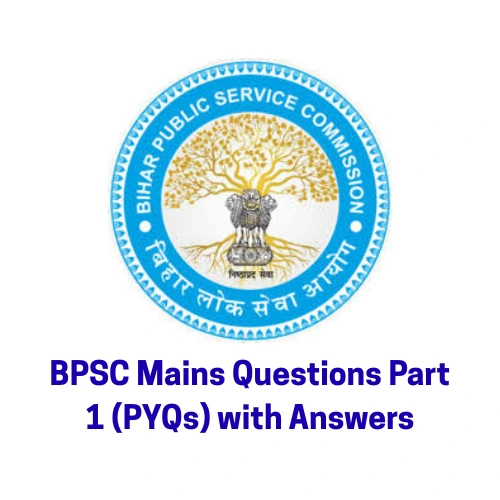Here the BPSC Mains Questions Part 1 in which the 70th BPSC Mains Short notes Sections with answers.
Write short notes on the following: (70th Mains Questions)
(a) The Indian Councils Act, 1861. (8 Marks)
(b) Role of Bihar in the Quit India Movement. (8 Marks)
(c) Santhal uprising. (Marks: 8)
(d) Patna Kalam painting. (7 Marks)
(e) Art and Architecture of Mauryan Age. (7 Marks)
BPSC Mains Questions Part 1 with Answers
Write short notes on the following: (70th BPSC Mains Questions Part 1)
(a) The Indian Councils Act, 1861. (Marks: 8)
(a) The Indian Councils Act, 1861. (Marks: 8)
Introduction: The Indian Councils Act, 1861 was a significant step in the constitutional development of India under British rule. It marked the beginning of legislative decentralization and laid the foundation for representative institutions in a limited form.
Background: The 1857 revolt exposed the weaknesses of British administration and created the need for reforms in governance. To strengthen control while allowing limited participation of Indians, the British Parliament enacted the Indian Councils Act, 1861.
Main Features of the Act
Expansion of Legislative Councils
The Governor-General’s Executive Council was expanded by including 6–12 additional members for legislative purposes.
For the first time, Indians were associated with law-making by nomination (e.g., Raja of Banaras, Maharaja of Patiala).
Decentralization of Powers
Legislative powers were given to the Presidencies of Bombay and Madras.
This marked the beginning of legislative decentralization.
Ordinance-Making Power
The Governor-General was authorized to issue ordinances in cases of emergency. It would remain valid for six months.
Restoration of Legislative Councils in Provinces
The Act permitted the establishment of legislative councils in Bengal, North-Western Provinces, and Punjab.
Significance of the Act
It initiated the process of involving Indians in governance, though in a very limited and controlled manner.
It laid the foundation for legislative institutions and the policy of decentralization.
It strengthened British control while trying to appease Indian sentiments post-1857.
Limitations
Indian participation was purely nominal. Members had no real power.
Councils functioned only as advisory bodies without authority to challenge British policies.
Conclusion: The Indian Councils Act of 1861 was a landmark in India’s constitutional history as it introduced legislative councils and decentralization, sowing the seeds for future reforms. However, it provided only symbolic Indian representation, keeping real power firmly in British hands.
Write short notes on the following: (70th BPSC Mains Questions Part 1)
(b) Role of Bihar in the Quit India Movement. (Marks: 8)
(b) Role of Bihar in the Quit India Movement. (Marks: 8)
Introduction: The Quit India Movement, launched on 8th August 1942 by Mahatma Gandhi, marked a decisive call for ending British rule. Bihar played a significant role in this movement, contributing leaders, mass mobilization, and revolutionary activities that gave momentum to the struggle.
Main Body
- Active Leadership:
- Dr. Rajendra Prasad, Anugrah Narayan Sinha, and Jayaprakash Narayan mobilized the people of Bihar.
- Jayaprakash Narayan emerged as a key underground leader, organizing resistance after being released from Hazaribagh jail in 1942.
- Mass Participation:
- Peasants, students, and workers joined the movement, turning it into a people’s uprising.
- In Patna and other districts, protests, strikes, and processions demanded the British leave India.
- Revolutionary Actions:
- In August 1942, police stations, post offices, and railway stations were attacked in districts like Saran, Champaran, and Bhagalpur.
- At places, parallel governments were briefly established, reflecting local self-rule.
- Sacrifices:
- Many protesters were killed in police firing, and thousands were arrested.
- The sacrifices of leaders and common people alike highlighted Bihar’s determination for independence.
Conclusion: The Quit India Movement in Bihar was marked by both non-violent protests and underground revolutionary actions. It showcased the courage, sacrifice, and organizational strength of the people, making Bihar a crucial pillar of the nationwide struggle for freedom.
Write short notes on the following: (70th BPSC Mains Questions Part 1)
(c) Santhal uprising. (Marks: 8)
(c) Santhal uprising. (Marks: 8)
Introduction: The Santhal Uprising, also known as the Santhal Hul, was one of the earliest tribal revolts against British colonial authority and exploitative practices of moneylenders and landlords. It broke out in June 1855 under the leadership of Sidhu and Kanhu Murmu in the Rajmahal Hills (present-day Jharkhand).
Causes of the Uprising:
Exploitation by Moneylenders (Mahajans): Santhals were trapped in debt, losing land and freedom.
Oppression by Zamindars and Police: High rent, illegal levies, and harassment deepened their misery.
British Land Revenue Policies: Permanent Settlement benefitted zamindars but ruined peasants and tribals.
Loss of Traditional Land & Culture: Expansion of agriculture, forests clearance, and outsiders’ intrusion threatened their identity.
Course of the Revolt:
On 30 June 1855, Sidhu and Kanhu, along with Chand and Bhairav, mobilized over 10,000 Santhals.
Attacks were carried out against moneylenders, zamindars, and British officials.
Villages, police stations, and colonial establishments were targeted in the Rajmahal and Bhagalpur regions.
The British retaliated with severe force; thousands of Santhals were killed, and the revolt was brutally suppressed by early 1856.
Significance:
It exposed the exploitation of tribal communities under colonial and feudal systems.
Though suppressed, it became a symbol of tribal assertion, courage, and sacrifice.
It influenced later tribal and peasant movements in India.
Conclusion: The Santhal Uprising was not merely a revolt against economic exploitation but also a defense of tribal identity and autonomy. Led by Sidhu and Kanhu, it stands as a landmark in India’s freedom struggle, reflecting the determination of marginalized communities to resist injustice.
Write short notes on the following: (70th BPSC Mains Questions Part 1)
(d) Patna Kalam painting. (Marks: 7)
(d) Patna Kalam painting. (Marks: 7)
Introduction: Patna Kalam painting, also known as the Company style of Patna, was a unique regional art form that developed in Bihar during the late 18th and early 19th centuries. It represents a blend of Mughal miniature traditions and local artistic expressions under the patronage of the East India Company officials.
Origin and Development:
Evolved after the decline of Mughal patronage, when displaced artists from Delhi and Murshidabad settled in Patna.
Flourished under the support of local aristocrats and British patrons.
Features of Patna Kalam:
Unlike traditional Mughal art, these paintings focused on the life of common people rather than royalty.
Painted on paper, mica, or ivory with fine detailing and bright colors.
Subjects included daily occupations—traders, craftsmen, washermen, festivals, processions, and bazaar scenes.
Absence of elaborate backgrounds; emphasis was on the figure or main theme.
Patrons and Influence:
British officers and European travelers commissioned these works as souvenirs.
The style gained popularity due to its realism and depiction of Indian social life.
Significance:
Patna Kalam reflects the socio-economic life of 18th–19th century Bihar.
It bridged the decline of Mughal miniature art with the rise of modern Indian painting.
Recognized as the earliest school of painting in India to focus on everyday life.
Conclusion: Patna Kalam painting stands out for its realistic portrayal of common people and daily activities. It is an important cultural heritage of Bihar, reflecting both continuity of Mughal art traditions and adaptation to colonial influences.
Write short notes on the following: (70th BPSC Mains Questions Part 1)
(e) Art and Architecture of Mauryan Age. (Marks: 7)
(e) Art and Architecture of Mauryan Age. (Marks: 7)
The Mauryan Age (322–185 BCE) marked the beginning of monumental art and architecture in India. With royal patronage, especially under Chandragupta, Bindusara, and Ashoka, Mauryan art reflected political power, religious devotion, and technical excellence.
Palace Architecture:
The Mauryan capital at Pataliputra housed grand wooden palaces and audience halls, influenced by Persian and Greek styles.
Megasthenes described Chandragupta’s palace as more magnificent than the palaces of Susa and Ecbatana.
Stone Architecture:
Transition from wood to stone was a key feature of Mauryan art.
Remains at Kumrahar (Pataliputra) reveal pillared halls with polished stone columns.
Stupas:
Ashoka built numerous stupas to enshrine relics of the Buddha.
Famous examples: Sanchi, Bharhut, and Amaravati (later enlarged).
Stupas symbolized Buddhist faith and Mauryan devotion to Dharma.
Pillars:
Ashokan pillars are the finest specimens of Mauryan architecture.
Made of single stone shafts with highly polished surfaces, crowned with animal capitals.
The Lion Capital at Sarnath is the most celebrated; it is now India’s National Emblem.
Rock-cut Architecture:
Early rock-cut caves like Barabar and Nagarjuni (in Bihar) were dedicated to Ajivikas by Ashoka.
These caves had polished interiors and simple, durable designs.
Sculpture and Art:
Yaksha and Yakshi figures at Didarganj and other sites reflect popular religious art.
Polished sandstone sculptures show mastery in realism and finish.
Conclusion: The Mauryan period represents a turning point in Indian art history, moving from perishable wood to enduring stone. Through stupas, pillars, sculptures, and rock-cut caves, Mauryan art expressed both royal authority and deep religiosity, laying the foundation for subsequent Indian art traditions.


